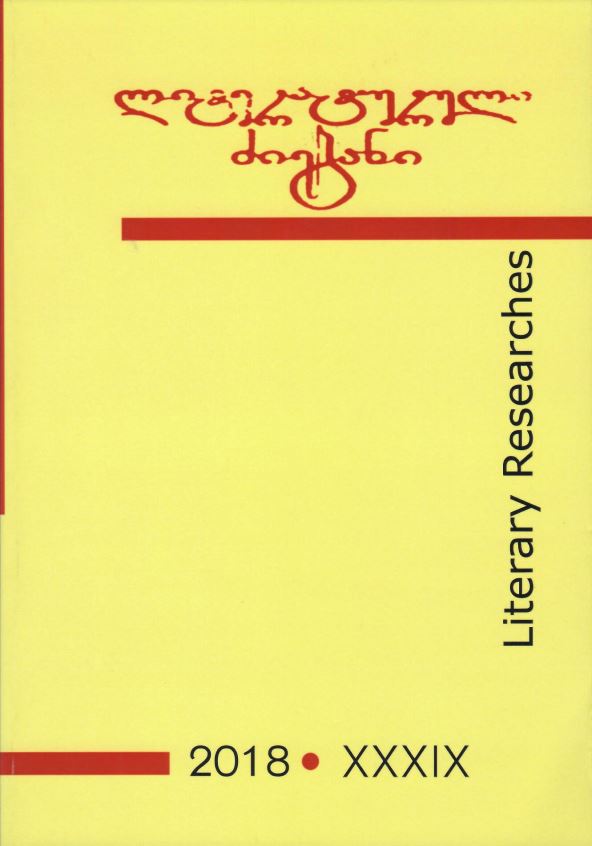გამოქვეყნებული 2018-12-20
საკვანძო სიტყვები
- Inter-Subjectivity,
- Being,
- Space,
- Time
როგორ უნდა ციტირება
ანოტაცია
Guram Rcheulishvili’s story “They Used to Tell in North Caucasus” is the outstanding example of the worldview and formal changes that showed up since 50s of 20th century, together with the political-ideological changes of post-Stalin stage in Georgian literature.
Writer’s deep interest to inter-subjectivity problem was expressed with particular emphasis
in the story “They Used to Tell in North Caucasus”, where the subject of extensive artistic work was existential nature of love, betrayal and revenge; paradoxical dynamic conflict of the internal structures of psychics and ambivalent nature of love. Against this background the spatial images acquire semiotic load, i.e. create the level of connotation meanings originating additional associative meanings of perceptions and beliefs related to time, history, internal nature of the human and existence.
In the story the time is very constricted. The author “captures” only certain pictures of the present – conditionally, from blooming of the lilacs to their decay. In this short period of phenomena no any cause and effect relationships can be seen as this is not a causal time. Here time is not substantial but rather characteristic of changing of existence, similar to Sartre’s works. And subjective time – is only transition, separating givenness between my actual and possibledesirable states.
The fable is built against the background of conflict between the external and internal spaces, due to this solution, the events development (and related time perception) is not linear, but rather planar, where the conflicting spaces, unexpected and different perceptions and finally, conflicting people meet.
External space is a district in a small city, where people can see a beautiful couple, husband and wife causing delight and rumors. This is one, conditionally mythological dimension of this story, event used by Guram in the title. The other dimension of the story is associated with the internal space of the couple’s relationships causing demythologization of the myth of love: secret of woman’s and man’s relationship in their family life – relationships without any romantic basis. Scant, precise narration manner adds some kind of evaluation dimension: the emphasis is made on clarity, nakedness, cruelty and anti-estheticism of what is going on. In this area there is a war and Guram’s eye – camera shows only two episodes of this war. The inner space itself is divided into two parts as well – two rooms, between which the characters move: hey enter and go out. They come into one of them like to the scene and go to the other like it was a backstage area.
In both episodes there are three characters, two of them – wife and husband are unchanged while the third one changes: in the first episode this is a man, in the second – woman. Both scenes depict adultery: one by the woman and the other – by the man. Both episodes are almost identical. The first episode is very dramatic, while the other – tragic. We face the cruelty and indifference of the demythologized world, existentialist “nothing” that is nothing else but negative being, “that turns into nothing”, that “watches the being”... “feeds itself with being... like some grub” (Sartre 2000: 46-47).
Guram Rcheulishvili reaches the terrible, dangerous depths of love, thinks about unusual opportunities and forms of revenge, sees, with the rare far-sightedness of the true writer dangerous, scaring depths and dimensions of our existence, unusual and cruel forms of violence that cause physical and mental decay of a person without elementary touch. He sees deadly irony of cold rationalism and dangerous aggression to the life and to the individual.
The key of the story is unmasking movement of a hand that reflects the man’s concealed and, supposedly, not yet understood desires: “man pushed the closed window, opened it and from there the rhythmic sound of raindrops and delicate lilac aroma rushed inside.” Movement of the husband’s hand is simultaneously associated with the concepts of freedom and destruction – both, one and another. This is the pulse to freedom that drives the pulse to destruction.
As the solution to the conceptual problem, Guram gives preference to external – spatial forms of human experience: pulse of change, betrayal, disappointment comes not only from the inner space of the apartment but from the outside as well. Against the background of at one glance insignificant, silent changes of spatial images we feel that the time of love, just like the time of lilacs blooming has ended, elapsed. Here the lilacs have apparently given the symbolic function, though it naturally, delicately fits into the existential picture painted by the writer.

